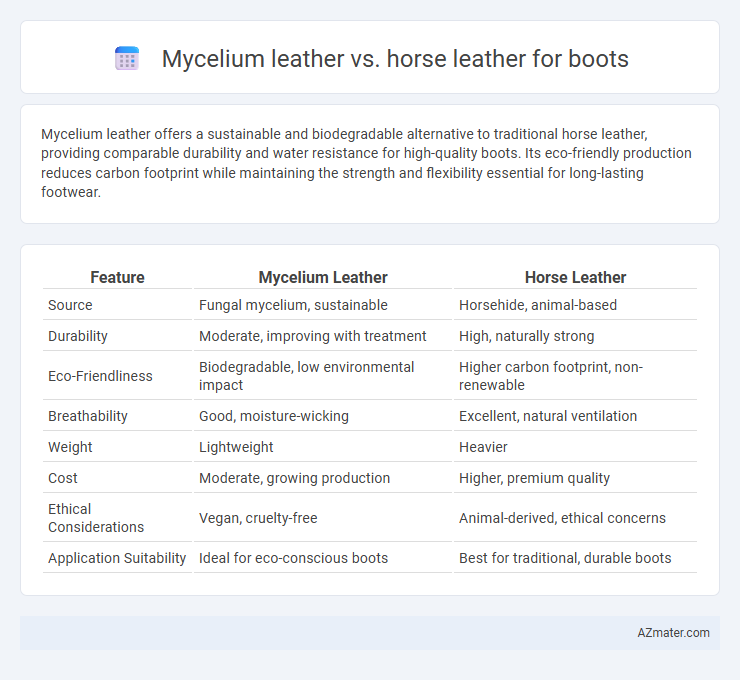Mycelium leather offers a sustainable and biodegradable alternative to traditional horse leather, providing comparable durability and water resistance for high-quality boots. Its eco-friendly production reduces carbon footprint while maintaining the strength and flexibility essential for long-lasting footwear.
Table of Comparison
| Feature | Mycelium Leather | Horse Leather |
|---|---|---|
| Source | Fungal mycelium, sustainable | Horsehide, animal-based |
| Durability | Moderate, improving with treatment | High, naturally strong |
| Eco-Friendliness | Biodegradable, low environmental impact | Higher carbon footprint, non-renewable |
| Breathability | Good, moisture-wicking | Excellent, natural ventilation |
| Weight | Lightweight | Heavier |
| Cost | Moderate, growing production | Higher, premium quality |
| Ethical Considerations | Vegan, cruelty-free | Animal-derived, ethical concerns |
| Application Suitability | Ideal for eco-conscious boots | Best for traditional, durable boots |
Introduction to Mycelium and Horse Leather
Mycelium leather, derived from the root structure of fungi, offers a sustainable and biodegradable alternative to traditional animal hides by mimicking the texture and durability of natural leather. Horse leather, sourced from horsehide, is renowned for its toughness, flexibility, and longevity, making it a premium choice for durable boots. Both materials provide unique strengths: mycelium leather excels in eco-friendly production, while horse leather remains a classic option valued for its natural resilience and rich grain.
Sustainability: Mycelium vs Horse Leather
Mycelium leather offers a highly sustainable alternative to traditional horse leather by utilizing fast-growing fungal networks that require minimal water, no harmful chemicals, and generate less carbon emissions during production. Horse leather production involves raising and processing animals, which has a higher environmental footprint due to land use, water consumption, and greenhouse gas emissions. Choosing mycelium leather for boots significantly reduces ecological impact while maintaining durability and aesthetic appeal similar to horse leather.
Ethical Considerations in Leather Production
Mycelium leather offers a sustainable and cruelty-free alternative to traditional horse leather in boot production, significantly reducing animal exploitation and environmental impact. The production of mycelium leather requires less water, land, and emits fewer greenhouse gases compared to horse leather, aligning with ethical standards for eco-conscious consumers. Choosing mycelium leather supports the shift towards cruelty-free fashion while addressing concerns about animal welfare and resource-intensive leather sourcing.
Durability and Longevity Comparison
Mycelium leather offers impressive durability with natural resistance to wear and environmental factors, making it a sustainable alternative to traditional horse leather. Horse leather is renowned for its toughness and ability to develop a unique patina over time, enhancing boot longevity through consistent conditioning and care. Comparing both, mycelium leather shows emerging potential for long-lasting use, while horse leather remains a proven, time-tested option for durable boot construction.
Comfort and Wearability for Boots
Mycelium leather offers superior breathability and flexibility compared to traditional horse leather, enhancing comfort during extended wear. Its lightweight, moisture-wicking properties reduce foot fatigue and improve overall wearability for boots. Horse leather remains durable and sturdy but tends to be stiffer and less forgiving, requiring longer break-in periods.
Aesthetic and Design Versatility
Mycelium leather offers a unique, textured surface that mimics natural grain with customizable patterns, enhancing aesthetic appeal and modern design versatility for boots. Horse leather provides a classic, smooth finish with a rich patina that develops over time, appealing to traditional and heritage-style boot designs. Both materials excel in durability, but mycelium allows for innovative coloring and shaping techniques that push creative boundaries in footwear design.
Environmental Impact Analysis
Mycelium leather offers a significantly lower environmental footprint than horse leather, as it is cultivated from mushroom roots through a carbon-neutral process that requires minimal water and no animal farming. Horse leather production involves intensive resource consumption, including water, feed, and land, contributing to higher greenhouse gas emissions and deforestation concerns. Adopting mycelium leather for boots reduces reliance on livestock-based leather and supports sustainable, biodegradable material innovation.
Cost and Accessibility
Mycelium leather offers a cost-effective and sustainable alternative to traditional horse leather, with production costs generally lower due to the use of rapidly renewable fungal materials. Accessibility of mycelium leather is increasing as innovative startups scale up manufacturing, while horse leather remains widely available but often involves higher expenses related to animal raising, processing, and environmental regulations. Consumers seeking affordability and eco-friendly options may prefer mycelium leather boots, whereas horse leather boots appeal to those prioritizing classic durability and established market presence.
Maintenance and Care Requirements
Mycelium leather requires minimal maintenance with simple cleaning using a damp cloth and occasional conditioning with natural oils to preserve its texture and durability. Horse leather, known for its toughness and longevity, demands regular cleaning, conditioning, and waterproofing to prevent cracking and maintain suppleness. Both materials benefit from proper storage away from direct sunlight and moisture to extend their lifespan and appearance.
Market Trends and Future Outlook
Mycelium leather is rapidly gaining traction in the sustainable fashion market due to its eco-friendly production process and biodegradability, appealing to environmentally conscious consumers. Horse leather has a long-standing reputation for durability and luxury, yet faces declining demand amid animal welfare concerns and regulatory constraints. Market trends indicate a growing shift toward mycelium leather, with projections suggesting it will capture a significant share of the boot industry as innovation reduces costs and improves material performance.

Infographic: Mycelium leather vs Horse leather for Boot
 azmater.com
azmater.com